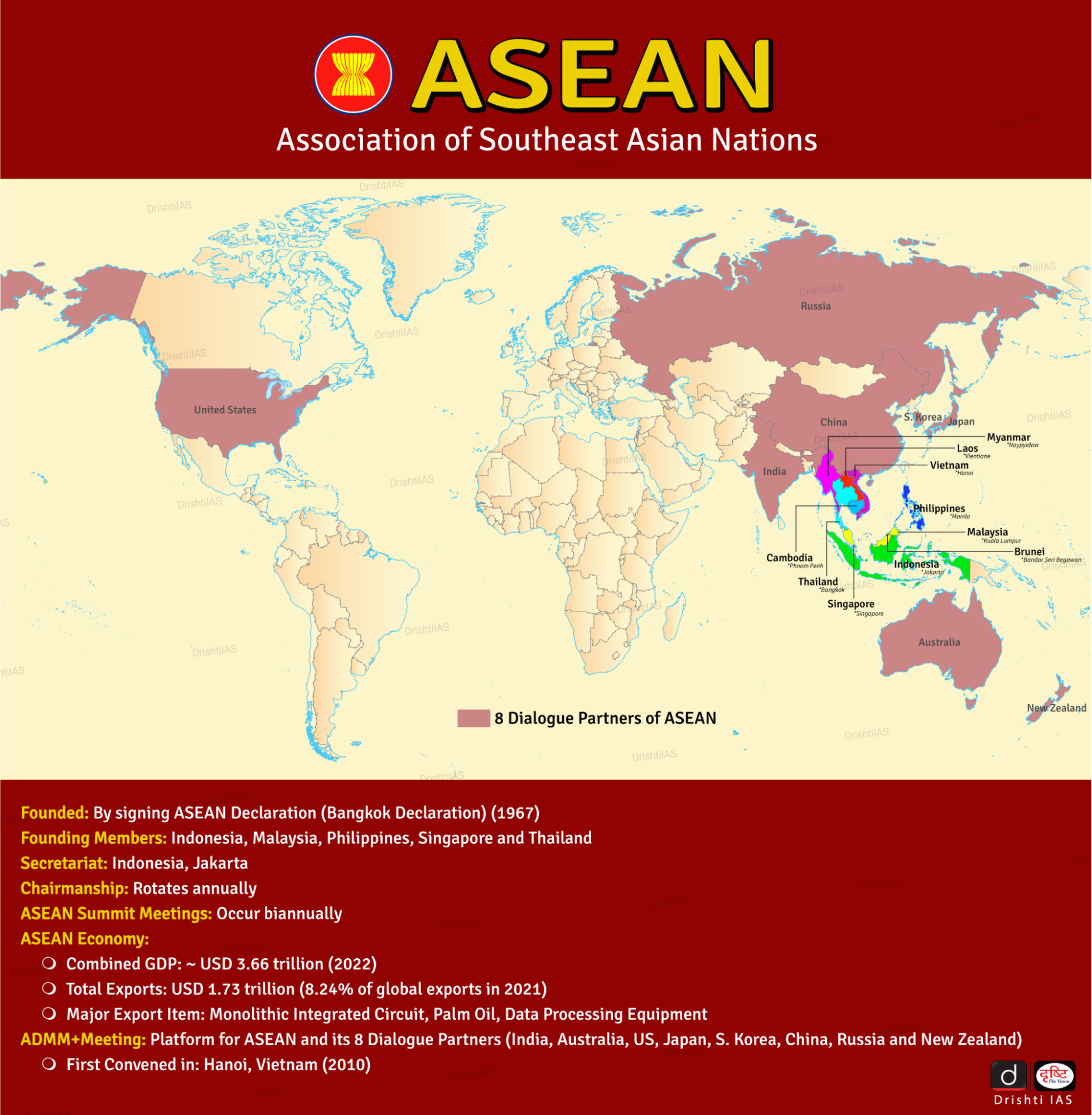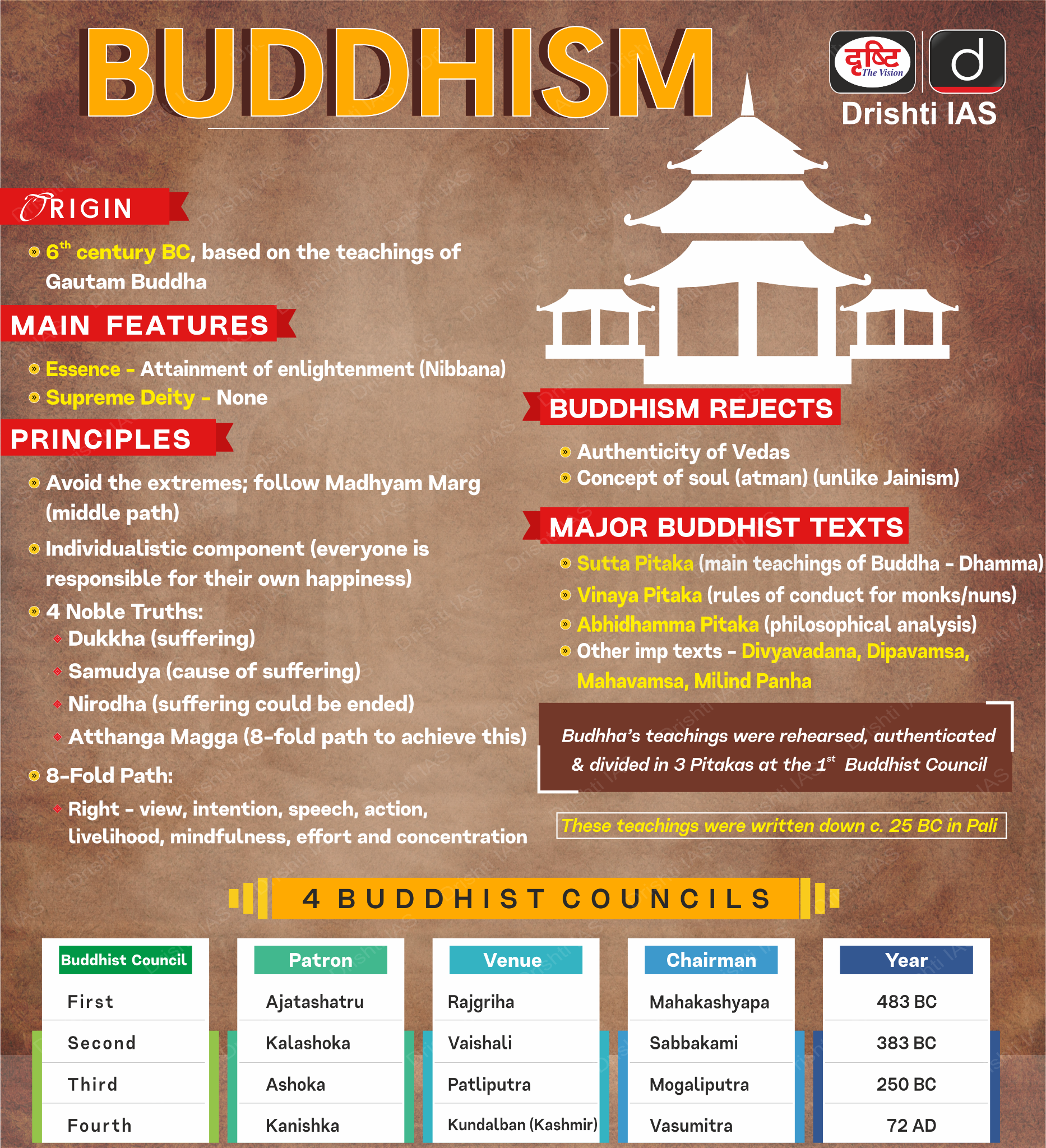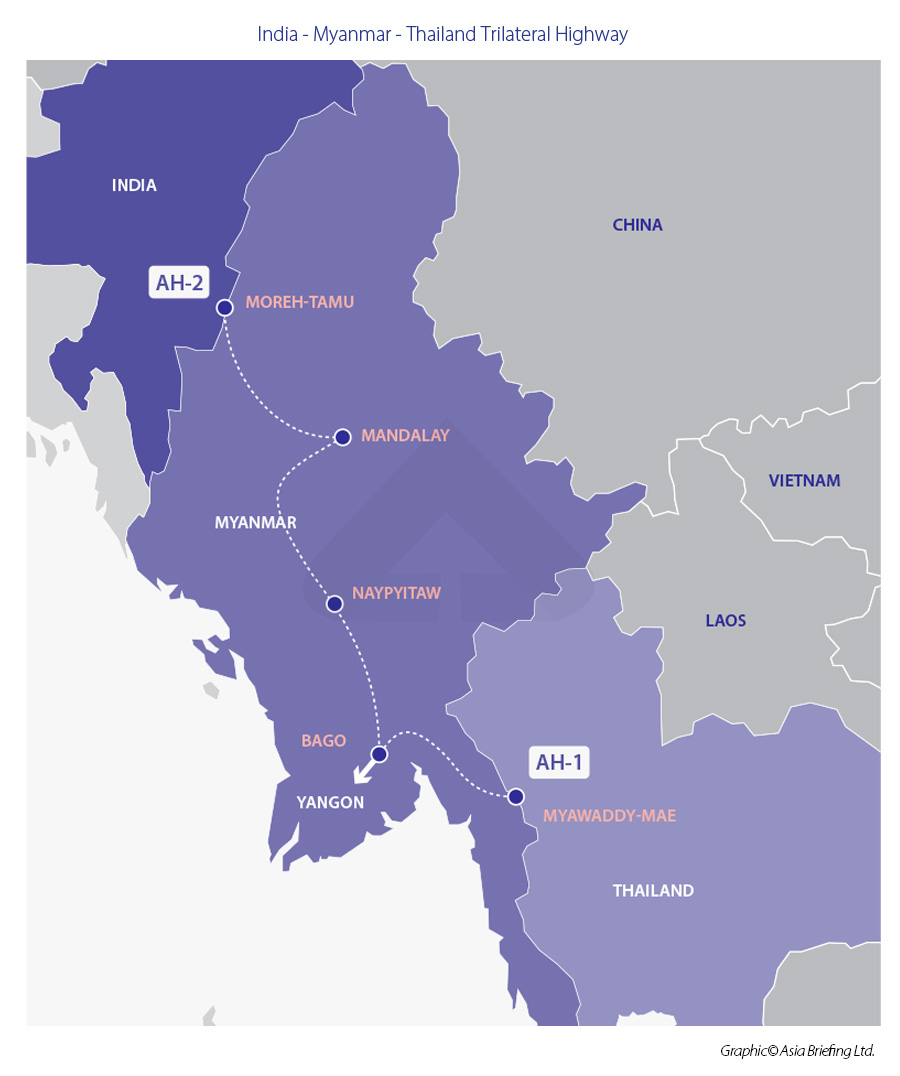11th ADMM Meeting-Plus and Buddhism | 25 Nov 2024
For Prelims: ASEAN Defence Ministers’ Meeting-Plus, Buddhist Principles, Act East policy, United Nations Convention on the Law of the Sea (UNCLOS), 1982, ASEAN, Global Commons, High Seas, Antarctica, Outer Space, Vinaya Pitaka, Bay of Bengal Initiative for Multi-Sectoral Technical and Economic Cooperation (BIMSTEC), India-Myanmar-Thailand Trilateral Highway Project, Indian Ocean Rim Association (IORA).
For Mains: India’s Act East Policy, India and its neighbourhood- relations.
Why in News?
Recently, India’s Defence Minister addressed the 11th ASEAN Defence Ministers’ Meeting-Plus (ADMM-Plus) forum held in Vientiane, Lao PDR.
- He emphasised the role of Buddhist principles in resolving conflicts and celebrated a decade of India's Act East policy (AEP).
What are the Key Highlights of the 11th ADMM Meeting-Plus?
- Freedom of Navigation: India highlighted the need for adherence to the United Nations Convention on the Law of the Sea (UNCLOS), 1982 for freedom of navigation and overflight in the Indo-Pacific region.
- India advocated for a Code of Conduct that protects the rights and interests of nations that remain consistent with international law.
- International Order: India called for greater adoption of Buddhist principles of peaceful coexistence in a world that is increasingly polarised into blocks and camps.
- Advocacy for Dialogue: India’s approach to border disputes, trade agreements, and other challenges demonstrates its belief in open communication to foster trust, understanding, and cooperation.
- Asian Century: India described the 21st century as the "Asian Century," emphasising ASEAN’s economic dynamism and its vibrant trade, commerce, and cultural exchanges.
- Decade of the Act East Policy: India Highlighted the success of India’s Act East Policy, which has strengthened ties with ASEAN and Indo-Pacific nations over the past decade.
- The Act East Policy was launched in November 2014 at the 12th ASEAN-India Summit 2014 held in Myanmar capital Naypyidaw.
- Climate Change and Defence: India proposed the development of an ADMM-Plus Defence Strategy on Climate Change to tackle interlinked security and environmental challenges.
- Global Commons: India underscored the importance of safeguarding Global Commons, which include shared natural resources beyond national boundaries.
- Global Commons include High Seas, Atmosphere, Antarctica and Outer Space.
Note:
India quoted Rabindranath Tagore’s 1927 remark during his Southeast Asia visit: "I saw India everywhere, yet I couldn’t recognise it."
- The statement symbolises the deep and widespread cultural & historical ties between India and SouthEast Asia.
What is ADMM-Plus Forum?
- About: It is a multilateral defence cooperation framework that brings together the defence ministers of the 10 ASEAN member states, 8 Plus countries (dialogue partners), and Timor Leste.
- ASEAN Members include Brunei, Cambodia, Indonesia, Laos, Malaysia, Myanmar, the Philippines, Singapore, Thailand, Vietnam.
- 8 Dialogue partners include India, China, Russia, Japan, South Korea, Australia, New Zealand and the US.
- Establishment: The Inaugural ADMM-Plus was convened in Ha Noi, Viet Nam, on 12th October 2010.
- Since 2017, the ADMM-Plus meets annually, to allow enhanced dialogue and cooperation among ASEAN and the Plus Countries.
- Focus Area: The ADMM-Plus currently focuses on seven areas of practical cooperation, namely
- Maritime security (MS)
- Counter-terrorism (CT)
- Humanitarian assistance and disaster management (HADR)
- Peacekeeping operations (PKO)
- Military medicine (MM)
- Humanitarian mine action (HMA)
- Cyber security (CS)
- Experts’ Working Groups (EWGs): EWGs have been established to facilitate cooperation in these areas.
- The EWGs are each co-chaired by one ASEAN Member State and one Plus Country, operating in a three-year cycle.
Spread of Buddhism to Southeast Asia
- Cultural Crossroads: Indian traders, sailors, and monks helped spread Buddhism to Southeast Asia, with ports like Srivijaya (Sumatra, Indonesia) and Champa (Vietnam) serving as key centres for learning and cultural exchange from the 7th to 13th centuries.
- Legitimacy of Rulers: Southeast Asian rulers adopted Buddhism to strengthen their authority, aligning with figures like Buddha or Hindu deities to legitimise their rule.
- The Srivijaya Empire, centered in Sumatra, was a key player in the spread of Buddhism.
- Fusion of Hinduism and Buddhism: In Southeast Asia, Buddhism often blended with local beliefs and Hinduism.
- Buddhist and Hindu temples in Southeast Asia, like Angkor Wat (Cambodia) and Borobudur (Indonesia), showcase this fusion.
- Cultural Diffusion: Buddhism influenced the local cultures of places like Bali and Java, seen in their dance, rituals, and temple architecture.
What is the Role of Buddhist Ideals in Conflict Resolution?
- Buddhist Perspectives: Three vital Buddhist perspectives that can help us resolve or minimise conflict.
- Everyone is a Buddha, worthy of utmost respect.
- Dialogue is the most powerful means of creating understanding and respect among people.
- Our inner transformation is the key to changing the world (reducing the poison of anger which includes greed (lobha), hatred (dvesha), and delusion (moha).
- Adhikaraṇasamathadhamma: Buddhist text Vinaya Pitaka outlines adhikaraṇasamathadhammā, principles for resolving monks' conflicts.
- It provides detailed guidelines for monks on confession, reconciliation, resolving disputes, and healing splits in the Sangha.
- It applies to anyone seeking reconciliation of differences, whether personal or political.
- It provides detailed guidelines for monks on confession, reconciliation, resolving disputes, and healing splits in the Sangha.
- Middle Path (Madhyam Marg): Advocating balanced policies that consider all stakeholders' needs, fostering equitable solutions while avoiding extremes.
- Interdependence (Pratītyasamutpāda): Promoting mutual understanding and shared responsibility among nations to address global issues like climate change and resource conflicts.
- Karuna (Compassion): Prioritising humanitarian aid and addressing the root causes of suffering in conflict zones, such as poverty and inequality.
What is India’s Act East Policy (AEP)?
- About: India's AEP is a strategic initiative aimed at strengthening India's engagement with the countries of Southeast Asia, East Asia, and the broader Indo-Pacific region.
- It evolves from the Look East Policy, 1992, focusing on proactive engagement to boost economic growth, regional security, and cultural exchanges.
- Strategic Partnerships: India has upgraded its relations to strategic partnerships with several key countries in the region, including Indonesia, Vietnam, Malaysia, Japan, the Republic of Korea (ROK), Australia, and Singapore.
- Regional Engagement: India is actively involved in the ASEAN Regional Forum (ARF), East Asia Summit (EAS), the Bay of Bengal Initiative for Multi-Sectoral Technical and Economic Cooperation (BIMSTEC), Asia Cooperation Dialogue (ACD), Mekong Ganga Cooperation (MGC), and Indian Ocean Rim Association (IORA).
- Infrastructure, and Connectivity: Major infrastructure projects include the Kaladan Multi-modal Transit Transport Project, India-Myanmar-Thailand Trilateral Highway Project, Rhi-Tiddim Road Project, and Border Haats.
- Security Cooperation: There is a shared commitment between India and ASEAN to upholding international maritime laws and norms and promoting regional stability.
- Northeast India: Efforts focus on improving connectivity between Northeast India and ASEAN through trade, cultural exchanges, and infrastructure development.
- India-Myanmar-Thailand trilateral highway (Asian trilateral highway) will connect India (Moreh, Manipur) and Thailand (Mae Sot) via Myanmar and is planned to be extended to Cambodia, Laos, and Vietnam.
Conclusion
India's participation in the 11th ADMM-Plus highlights its commitment to regional peace, security, and cooperation. Emphasising Buddhist principles for conflict resolution, the Act East Policy's success, and climate change defence strategies reflect India's broader vision for a peaceful, integrated, and sustainable Indo-Pacific region.
|
Drishti Mains Question: Examine the relevance of Buddhist principles in today's global order for peace and harmony. |
UPSC Civil Services Examination, Previous Year Questions (PYQs)
Prelims
Q. Consider the following countries: (2018)
- Australia
- Canada
- China
- India
- Japan
- USA
Which of the above are among the ‘free-trade partners’ of ASEAN?
(a) 1, 2, 4 and 5
(b) 3, 4, 5 and 6
(c) 1, 3, 4 and 5
(d) 2, 3, 4 and 6
Ans: (c)
Q. The term ‘Regional Comprehensive Economic Partnership’ often appears in the news in the context of the affairs of a group of countries known as(2016)
(a) G20
(b) ASEAN
(c) SCO
(d) SAARC
Ans: (b)
Mains
Q. Evaluate the economic and strategic dimensions of India’s Look East Policy in the context of the post Cold War international scenario. (2016)



